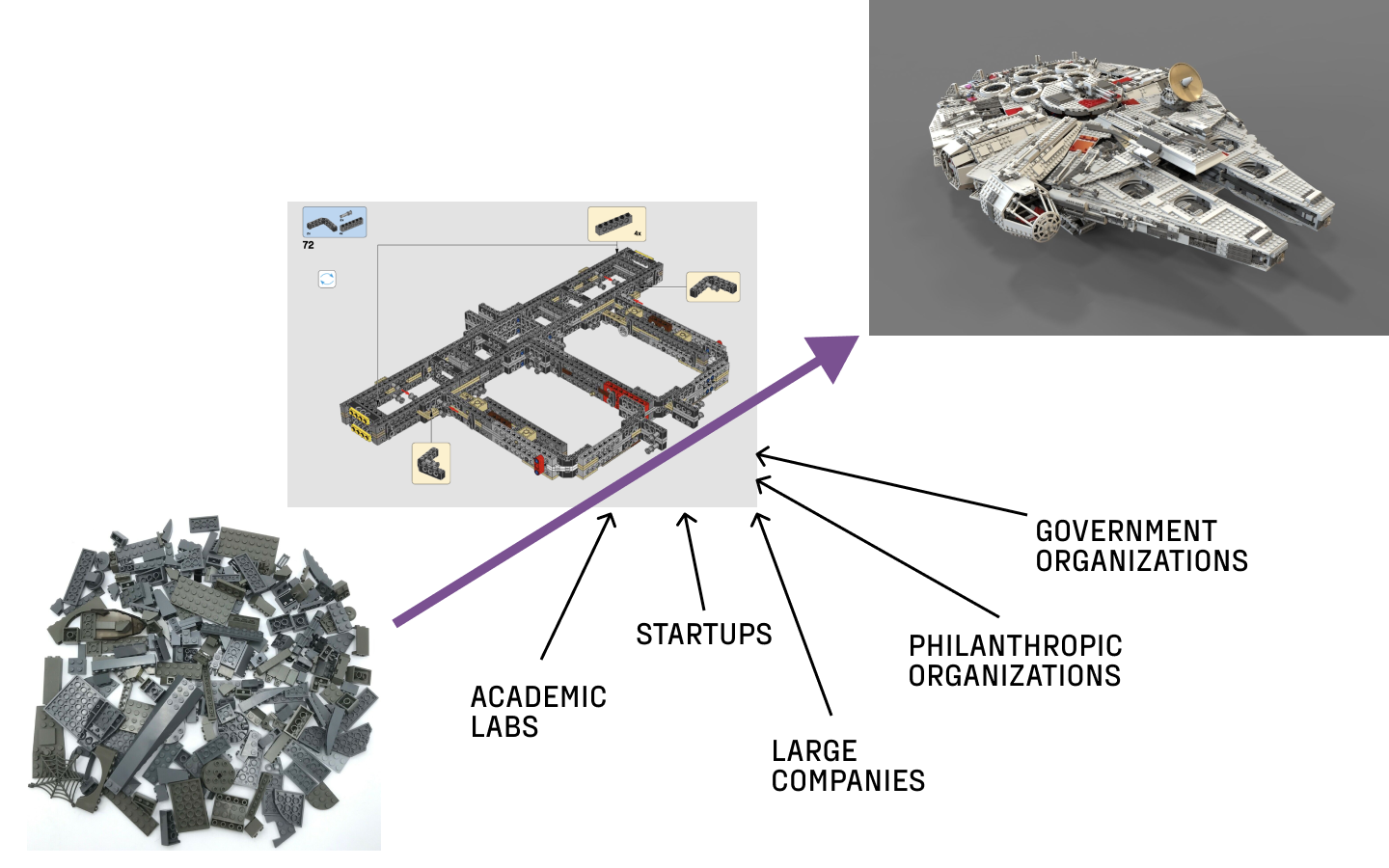Introducing Speculative Technologies
A new research organization

We’re excited to announce the launch of Speculative Technologies — a new nonprofit research organization. Our mission is to create an abundant, wonder-filled future by unlocking powerful materials and manufacturing technologies that don’t have a home in other institutions. Speculative Technologies runs research programs across multiple organizations to derisk technologies that are too long-term, unjustifiable, multidisciplinary or public-goods oriented for other institutions.
The future is full of possibilities — visiting friends who live on the other side of the world for afternoon coffee, a Michelin-star meal created atom-by-atom in your kitchen, playing basketball with your great-grandkids, to list a few. If history is a lesson, there are incredible possibilities we can’t yet imagine.
But this future is fragile. Two centuries of explosive growth, invention, and discovery have given technological and scientific progress the guise of natural laws. It’s easy to think that trends will inevitably continue up and to the right. In reality, those trends depend on a delicate ecosystem: a combination of culture, institutions, and extraordinary effort by individuals acting far beyond reason. This ecosystem has growing cracks: 44% of researcher’s time is spent writing and administering grants; 78% percent of researchers at top institutions would change their research direction if they were unconstrained; extraordinary numbers of PhDs in science or physical engineering don’t work in technical areas at all; we wonder whether ideas themselves are getting harder to find.
We need new institutional structures for research. Today, professors need to publish more, startups need to grow more quickly, and companies need to justify their balance sheets more than in the past. It’s unlikely that Shockley’s work to build the transistor or Engelbart’s to create personal computing would survive today. Karikó’s mRNA vaccines barely did. How many game-changing technologies have died because they couldn’t find a home in our innovation ecosystem? The world has changed and how we enable great discoveries and inventions must change as well. Regardless of whether we’ve picked innovation’s “low-hanging fruit” or even whether invention and discovery has slowed down at all, we can do dramatically better.
What we’re doing
Speculative Technologies runs coordinated research programs to unlock new ways of building things and new materials to build those things from.
We’re actively running two programs (and have several more in the works!):
- Molecular Additive Manufacturing is creating heterogeneous materials whose structures can be specified down to nanoscale building blocks, potentially enabling us to engineer structures we depend on biology for today. By templating a precise pattern of covalently bonded proteins, polymers, and inorganic molecules, we could create powerful catalysts, membranes to easily filter water, and take the first steps on the path towards atomically precise manufacturing.
- Nanomodular Electronics is building a two-step process for manufacturing custom, on-demand microelectronics without etching silicon or a traditional fab. By creating tiny, modular components separately from laying them down and wiring them together, we could make custom microelectronics as easily as printing this document.
Our programs aim to unlock technologies that are potentially big if true. The world would be very different if people could create microelectronics on a desktop or program the structure of materials with incredible precision. However, these technologies are very much still research, not products. There is deep uncertainty about timelines and outcomes. A program’s goal is to first show that a technology could work at all and then make it sufficiently un speculative to the point where it can continue in other institutions – whether that’s as a startup, a government research program, or part of a larger company. Our job is to turn the impossible into the inevitable.
In addition to our two active programs, we are also working on spinning up programs in other frontiers of materials and manufacturing that need speculative system-building: extracellular biology, robotics, chemicals, ‘traditional’ manufacturing, and more.
Materials and manufacturing may seem removed from the world’s most important problems: war, poverty, inequality, climate change, sickness, and death. But materials and manufacturing are upstream of all these problems. The time and money that we pour into therapeutics and carbon removal are not a complete waste, but without entirely new ways to rearrange atoms, materials to contain fission and fusion power, and new ways to make technology that breaks us out of our hyper-optimized and fragile paradigms, there are diminishing returns to work that directly attacks big problems. The history of technology is dominated by second-order effects: we solved many huge problems not by working on them directly, but by creating powerful technologies – the Haber-Bosch process, steel, electricity, refrigeration, and beyond. More broadly, new frontiers obsolete old problems, break us out of zero-sum games, and create human agency. New frontiers require new tools.
Creating new materials and manufacturing processes requires cycling between invention and discovery: building a prototype and trying to use it for something serious reveals scientific problems whose solutions propagate through the system’s design. This “systems research” flies in the face of the linear “basic research -> applied research -> commercialization” pipeline. It simultaneously requires both creative tinkering and grungy engineering work over several years. It demands planning and coordination between several disciplines with divergent ways of working. In the past this work was done in the basements of inventors or by legendary organizations like Bell Labs or the original ARPA.
There are many reasons why we can’t resurrect the era of solo inventors or rebuild Bell Labs. However, a small research organization can perform surgical interventions to kickstart the sort of work those organizations once supported: incentivizing disparate groups to work on a single system, showing that a technology might not be impossible, and shining a light on how it can grow into something inevitable.

How we operate
Maximizing the impact of new technologies requires new systems, not just components. The lightbulb needed electrification, steam engines needed trains, and creating fertilizer from air required entire plants devoted to the Haaber-bosch process. You couldn’t just swap out a piece of an existing system. This kind of problem requires coordinated, interdisciplinary exploration and building – exactly what Speculative Technologies’ model is designed to do.
Speculative Technologies’ “core gameplay loop” revolves around multi-year programs run by program managers with wide-ranging authority to coordinate several projects towards a single vision. Our model is heavily inspired by DARPA, the government agency that unlocked technologies from the Internet to autonomous cars and mRNA vaccines. Each three- to five-year program goes through three major stages: design, derisking experiments, and then the main program itself.
Our program managers have deep technical expertise and a clear vision of a technology that can enable capabilities that don’t yet exist. We work with them to roadmap the steps to create that technology and empower them to start and coordinate projects across several organizations – academic labs, contract research orgs, or startups – towards that goal. Program managers don’t just pick projects — they actively make sure everybody is working towards a single output.
Running parallel projects across several organizations has advantages for building speculative technologies: it allows us to leverage expertise and equipment beyond what we could bring in house; it enables us to explore several competing approaches in parallel; and it enables us to quickly spin up and spin down projects.
This active research management contrasts with most grant-making organizations who put out a broad call for proposals, rank them, and select the top ones. In addition to wasting researcher time, the standard granting approach creates a cluster of related research, not functional systems. Of course, our approach isn’t for everyone — different flavors of research need different approaches!
We are an institutional experiment
Institutions are more than just their outputs. They also embody cultures and values that spread if the institution is successful. Some things we aspire to embody:
- A spirit of excellence. Great research tends to cluster — for any time period and domain, there are a few organizations that stand head and shoulders above the rest. We believe that, in order to achieve this effect, we need to hold ourselves to exacting standards.
- A spirit of adventure. We hope to open new frontiers. This requires a sense of adventure — if you don’t delight in stepping into the unknown, the uncertainty will break you.
- Planning and Speed, both applied judiciously. Planning isn’t particularly important when you’re improving existing technology. If capability is a landscape, you can just follow the slope to the top of a hill. But building new paradigms requires going down the slope to get onto a new hill that lets you climb higher than you could before. That process requires planning. At the same time, speed is one of the few advantages we have as a small new organization. The trick is to identify where planning is important and move quickly wherever it isn’t.
- Walking the line between wonder and seriousness. Creating new technologies is a serious business. It requires a combination of trust, money, and constant contact with reality. At the same time, the world crushes wonder out of so much of life. New technologies are the closest thing we have to magic – let’s bring wonder back into the world.
- Long games. Research takes time. Building the trust that is critical for enabling research takes longer. We’re in this for the long game.
Institutional experimentation is underrated. We’re committed to continually trying new ways of managing, funding, and planning research. Ideally, blazing a path for others to build new research organizations. Many institutional experiments come out of the gates with a bang but then quietly shut down or evolve to resemble other organizations. Those who succeed rarely document what they actually did until after valuable lessons become organizational mythology. Good experiments have good documentation — we’ve been posting high-level lessons in our newsletter and plan to work with the garage door open as much as possible.
Since most research is done in nonprofits, it might seem natural to structure Speculative Technologies that way too. But it’s not at all an obvious choice. If we were a venture-backed startup, it would make fundraising and hiring so much easier — equity is a powerful incentive. Profitable companies play a critical role in technology because at some point, every successful technology needs to become a successful product. Being a nonprofit breaks revenue-driven feedback loops, comes with a huge regulatory burden, and raises the very real question: “how do you become sustainable in the long run?” Nevertheless, we think it’s the best path because of the size and potential impact of the unexplored design space we can open by asking not “what technology would create a great company?” but “what technology would create a great future?”
But isn’t that the government’s job? The US government spent $142B on R&D in 2021, dwarfing any resources we could assemble. Government funding has generated game-changing inventions and Nobel prizes, but even DARPA is under a set of constraints that are unlikely to change. Foremost among those constraints is the need to legibly justify what they do and who they fund. But that’s the nature of new things: both unconventional research and unconventional institutions will always look foolish to all but a few. A private organization needs the support of a few speculators, not the consensus of a committee.
We need your help
A future that’s better than the present isn’t inevitable. Neither is our success. If our mission resonates with you, here is how you can help:
- We rely on your support for now. You can join our funders club by donating small amounts here. If you’re interested in doing something bigger to support an existing program, working with us to create a new program, or supporting the organization as a whole, please shoot us an email!
- If you or someone you know has a vision for a potential program please send us a 1 page summary!
- Send this essay to someone it might resonate with — as a small team, we depend on inbounds for both funding and ideas.
- Stay in touch — we’ll be posting news updates, organizational learnings, and research results on Substack.
At the end of the day, creating technology isn’t about cool gizmos or powerful systems: it’s about enabling more and better relationships; reducing stress, suffering, and unnecessary death; enabling people to pursue purpose and wonder; creating the sense that the lives of our children can be better than our own; generating abundance and opening frontiers that make zero-sum games obsolete. Success isn’t guaranteed, but for the sake of the future, we need to try.
Thanks to Kanjun Qiu, Eric Reis, James Phillips, Andy Matuschak, Adam Marblestone, Nadia Asparouhova and many others for reading drafts of this essay.
